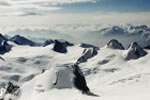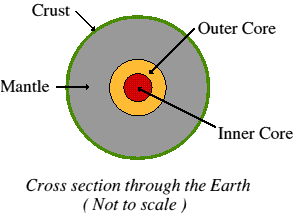


 |
 |
 |

Our planet was most probably created about five billion years ago. At first it was just a ball of molten rock and gasses with little order to its structure. The immense amount of heat energy released at this time is still being radiated, even today, as the planet slowly cools down.
As the cooling began, more dense materials such as iron (Fe) sank into the core of the Earth, while lighter silicates (Si), other oxygen (O) compounds, and water rose towards the surface. In consequence distinct layers began to form.
The Earth is made up of several of these different layers. The outer layer is called the Crust. It is made of the lighter, less dense, rocks that floated to the surface when the Earth was formed and is between 35km and 70km thick. The deepest mine in the world is only 3.3km deep, and nobody has ever been able to drill down further than 15km. Everything that exists below this depth is worked out by scientists using evidence from earthquakes, volcanoes and meteorites. Being relatively cold, the crust is rocky and brittle, so it can fracture during earthquakes. The crust is not a continuous layer of rocks but consists of large masses, called plates, which are free to drift slowly across the surface of the planet. There are two types of crust - Continental and Oceanic. Continental crust is less dense ( lighter), much older and much thicker than Oceanic crust. Continental crust floats on the mantle rather like an iceberg floats in water. Continental Crust : 35 - 70km thick, up to 3500 million years old Oceanic Crust : 6km thick, nowhere older than 200 million years
The layer of rock below the crust is called the Mantle. This is about 2,900km thick and contains most of the mass of the Earth. The upper part of the mantle is solid but at greater depths the heat causes the rock to behave more like a liquid. The high pressure, however, stops the rock from melting. It becomes 'plastic' at temperatures in excess of 1000°C and can flow. The rocks are mainly composed of iron (Fe), magnesium (Mg), aluminium (Al), silicon (Si), and oxygen (O) compounds.
Very hot rocks in the lower part of the mantle rise up through the cooler, upper, layers. As the rocks rise they cool and flow sideways. They then sink down again towards the core. This movement is called convection.
Below the mantle is the Core. This is probably liquid with a solid centre made of iron with a few other metals such as nickel. The centre, or Inner Core is incredibly hot, about 5,000°C and subjected to a pressure of about 4 million atmospheres! It is this extreme pressure that keeps the inner core in a solid state.
We value
your ideas and suggestions. Please contact the
maintainer of this site.
This page
can be found at: http://www.geography-site.co.uk
Last update to
this statement was on:
February 22, 2006
© Copyright Geography Site